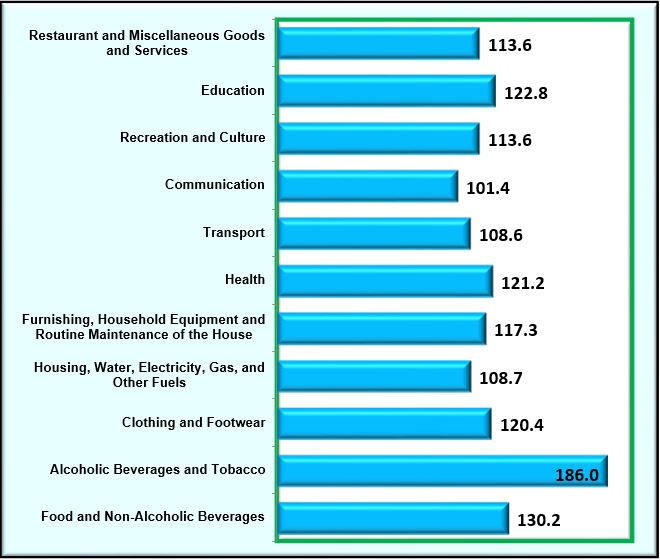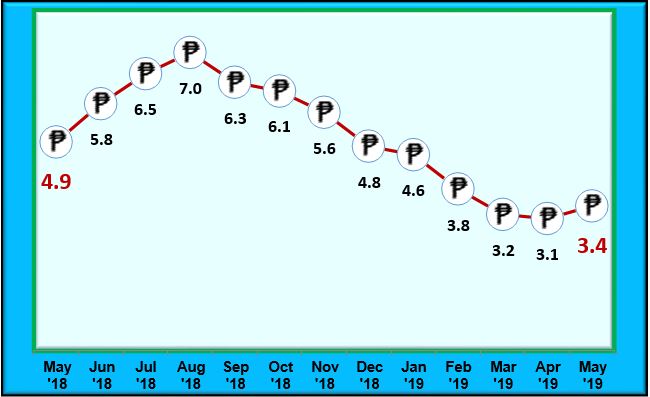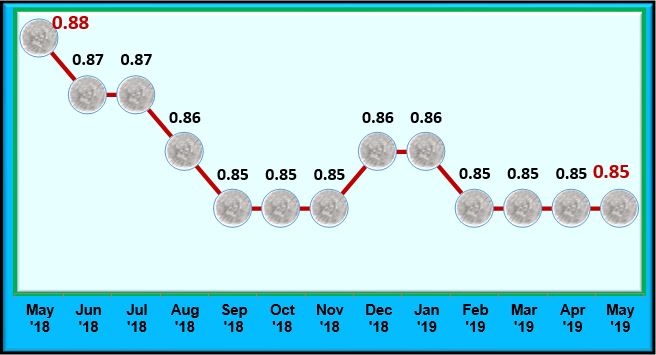This Special Release presents data on Consumer Price Index of National Capital Region for the month of May 2019 prepared by PO NCR IV (CAMANAVA).
National Capital Region Consumer Price Index (CPI) increased by 117.8%
Survey of Retail Prices of Commodities conducted by the Philippine Statistics Authority (PSA) has generated a Consumer Price Index (CPI) to 117.8 for National Capital Region (NCR) as of May 2019, using 2012 as the base year. This implies that the cost of a basket of goods and services commonly purchased by a typical Filipino household in different cities of NCR was at an average price of Php 117.8 as of May 2019. This means that for an average Filipino household to afford same values of goods and services in May 2012 at Php 100.00 needs an additional Php 17.80 in May 2019. In May 2018, CPI is equal to 113.9.
Table 1. Monthly Consumer Price Index for All Income Households in NCR, by Commodity Group: May 2018 - 2019 (2012 = 100)
| Commodity Group | May 2019 | May 2018 |
| All Items | 117.8 | 113.9 |
| Food and Non-Alcoholic Beverages | 130.2 | 125.0 |
| Alcoholic Beverages and Tobacco | 186.0 | 180.5 |
| Clothing and Footwear | 120.4 | 118.4 |
| Housing, Water, Electricity, Gas, and Other Fuels | 108.7 | 105.4 |
| Furnishing, Household Equipment and Routine Maintenance of the House | 117.3 | 115.5 |
| Health | 121.2 | 115.9 |
| Transport | 105.8 | 98.9 |
| Communication | 101.4 | 101.1 |
| Recreation and Culture | 113.6 | 111.0 |
| Education | 122.8 | 121.1 |
| Restaurant and Miscellaneous Goods and Services | 113.6 | 110.0 |
Source: Philippine Statics Authority, psa.gov.ph
Commodities under the groups of Food and Non-Alcoholic Beverages, Alcoholic Beverages and Tobacco, Health, and Transportation had increased by more than 5 percentage points compared with same month in 2018.
On the other hand, communication CPI recorded at 101.4 in May 2019 and 101.1 in the same month in 2018 both recording the lowest CPI among other commodity groups.
Figure 1. Consumer Price Index for All Income Households in the National Capital Region (NCR), by Commodity Group: as of May 2019 (2012 = 100)

Source: Philippine Statics Authority, psa.gov.ph
Inflation Rate
The average headline inflation rate in the National Capital Region (NCR) is at 3.4 percent as of May 2019 (2012=100). This implies that prices of commodities in all cities in the NCR recorded an average of 3.4 in 2019 compared to 4.9 in 2018 of the same period. This means that if you pay Php 15.00 for a can of sardines in May 2018 and if on the average prices went up by 3.4% after a year’s time, you will need Php 15.51 to buy same brand of a can of sardines in May 2019.
Figure 2. Year-on-Year Headline Inflation Rate in NCR, All Items: May 2018 – May 2019 (2012 = 100)

Source: Philippine Statics Authority, psa.gov.ph
Table 2. Year-on-Year Headline Inflation Rate in NCR, All Items by Commodity Group: May 2018- 2019 (2012 = 100)
| Commodity Group | May 2019 | May 2018 |
| All Items | 3.4 | 4.9 |
| Food and Non-Alcoholic Beverages | 4.2 | 5.1 |
| Alcoholic Beverages and Tobacco | 3.0 | 23.0 |
| Clothing and Footwear | 1.7 | 2.2 |
| Housing, Water, Electricity, Gas, and Other Fuels | 3.1 | 4.5 |
| Furnishing, Household Equipment and Routine Maintenance of the House | 1.6 | 2.9 |
| Health | 4.6 | 2.7 |
| Transport | 5.6 | 7.3 |
| Communication | 0.3 | 0.4 |
| Recreation and Culture | 2.3 | 1.4 |
| Education | 1.4 | 1.6 |
| Restaurant and Miscellaneous Goods and Services | 3.3 | 5.3 |
Source: Philippine Statics Authority, psa.gov.ph
Purchasing Power of Peso
Purchasing Power of Peso (PPP) is inversely related to inflation rate. Thus, as the inflation rate increases, PPP decreases. In the NCR, monthly PPP decreased by 3.4 percent in May 2019 compared to value of the same period in 2018.
The PPP in May 2019 was estimated at 0.84 and has been observed for four consecutive months, starting from February 2019 up to this May 2019. This means that a peso in May 2012, as the base year, values only 84 centavos in May 2019.
Figure 3. Purchasing Power of Peso in NCR (2012 = 100)

Source: Philippine Statics Authority, psa.gov.ph
Technical Notes
Consumer Price Index (CPI)
The CPI is an indicator of the changes in the average retail prices of a fixed basket of goods and services commonly purchased by households relative to a base year.
Uses of CPI
The CPI is most widely used in the calculation of the inflation rate and purchasing power of peso. It is a major statistical series used for economic analysis and as a monitoring indicator of government economic policy.
Computation of CPI
The computation of the CPI involves consideration of the following important points:
a. Base Period
The reference date or base period is the benchmark or reference date or period at which the index is taken as equal to 100.
b. Market Basket
A sample of the thousands of varieties of goods purchased for consumption and services availed by the households in the country selected to represent the composite price behavior of all goods and services purchased by consumers.
c. Weighting System
The weighting pattern uses the expenditures on various consumer items purchased by households as a proportion to total expenditure.
d. Formula
The formula used in computing the CPI is the weighted arithmetic mean of price relatives, the Laspeyre’s formula with a fixed base year period (2006) weights.
e. Geographic Coverage
CPI values are computed at the national, regional, and provincial levels, and for selected cities.
Inflation Rate
Is the rate of change of the CPI expressed in percent. Inflation is interpreted in terms of declining purchasing power of peso.
Headline Inflation
Refers to the rate of change in the CPI, a measure of the average standard “basket” of goods and services consumed by a typical family.
Purchasing Power of Peso
Shows how much the peso in the base period is worth in the current period. It is computed as the reciprocal of the CPI for the period under review multiplied by 100.
(Sgd) BELEN R. RAZO
Chief Statistical Specialist
PSA NCR IV- (CAMANAVA)
